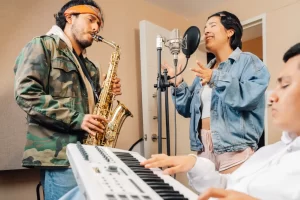In today’s interconnected world, the dream of reaching a global audience is more achievable than ever for musicians and artists. With the advent of digital platforms, social media, and streaming services, the barriers to international exposure have significantly lowered, opening up unparalleled opportunities for emerging talents. The potential benefits of cultivating a global fanbase are immense, offering artists not just a wider audience for their music but also diverse avenues for revenue, collaboration, and cultural exchange. This expansion beyond local or national boundaries can transform an artist’s career, providing a solid foundation for long-term success and sustainability in the music industry.
However, navigating the complex landscape of international music marketing requires more than just uploading your tracks online. It demands a strategic approach, an understanding of diverse cultural nuances, and a commitment to engaging with fans across different time zones and languages. Whether you’re an independent artist starting out or looking to expand your existing fanbase, the strategies for making your music resonate with listeners around the globe are multifaceted. From leveraging digital tools and platforms to localizing your content and live touring, the journey to global recognition is both challenging and rewarding. This guide aims to explore the key steps and considerations for artists aiming to make a mark on the international stage, providing insights into creating a universal appeal while staying true to your artistic vision. Welcome to the journey of marketing your music internationally and preparing to embrace a world of opportunities.
Understanding the Global Market
Delving into the global music market is akin to setting sail into vast, uncharted waters, where each region harbors its own unique set of preferences, trends, and cultural nuances. The global market is not monolithic; it is a mosaic of diverse audiences, each with its own musical tastes and consumption habits. Understanding this diversity is crucial for artists aiming to make their music resonate on an international level. It requires meticulous research to identify not only which countries or regions may be most receptive to your genre of music but also understanding the local music scene, popular platforms, and the competitive landscape.
The digital age has facilitated access to a wealth of information and data analytics tools that can help artists gain insights into where their music might already be gaining traction or where similar genres are popular. Platforms like Spotify and YouTube offer detailed analytics that can reveal surprising patterns in listener demographics and geographic locations. Additionally, engaging with social media metrics can provide a real-time pulse on your music’s global reach and audience engagement levels.
Yet, beyond numbers and data, understanding the global market also means appreciating the cultural context that shapes musical tastes. This might involve exploring local genres, traditions, and the current stars of those markets to find potential entry points or collaboration opportunities. Artists should be prepared to adapt their approach, whether through the themes of their music, the languages they sing in, or their marketing strategies, to truly connect with international audiences. Navigating the global market successfully thus combines strategic research with a deep respect and sensitivity towards cultural diversity, laying the foundation for a truly international musical career.
Leveraging Digital Platforms
In the quest to cultivate a global fanbase, digital platforms emerge as the linchpins in the strategy of any modern musician. The power of streaming services, social media, and digital marketing cannot be overstated in their ability to break down geographical barriers and connect artists with listeners from every corner of the globe. Platforms such as Spotify, Apple Music, and YouTube serve as global stages, where a single track can reach ears thousands of miles away, transcending borders with the click of a button. For artists, the key lies in not just being present on these platforms but optimizing their use to ensure maximum visibility and engagement.
Creating a comprehensive digital presence involves more than just uploading music. It includes curating engaging artist profiles, utilizing platform-specific features such as Spotify’s artist radio or YouTube’s video playlists, and ensuring your music is easily discoverable through proper tagging and SEO practices. Additionally, leveraging playlist placements through submission to playlist curators or generating your own can significantly boost your music’s exposure to new audiences.
Social media platforms, meanwhile, offer a direct line to fans, enabling artists to share their journey, promote new releases, and build a community around their music. Each platform has its own strengths – Instagram’s visual appeal, Twitter’s conversational nature, and Facebook’s group functionalities, for example – and understanding how to tailor content for each can amplify your reach.
Moreover, digital advertising through these platforms provides a targeted approach to reach potential fans based on their music preferences, demographic details, and even geographic location. By strategically using digital platforms, artists can effectively lay the groundwork for a global fanbase, engaging with audiences worldwide in a meaningful and impactful way.
Social Media Strategies
Crafting a compelling social media strategy is pivotal for artists looking to expand their global fanbase. In today’s digital landscape, social media is not just a tool for sharing content; it’s a dynamic platform for storytelling, fan engagement, and brand building. For musicians aiming to reach international audiences, social media offers a unique opportunity to create a narrative that resonates across different cultures and languages.
The first step in a successful social media strategy is understanding the unique features and audiences of each platform. Instagram, with its visually driven content, is ideal for sharing behind-the-scenes glimpses into your creative process, music video snippets, or visually appealing artwork related to your music. Twitter, conversely, allows for real-time engagement with fans through conversations, polls, and quick updates, making it perfect for announcements and discussions. Facebook’s strength lies in its ability to create communities through fan pages and groups, facilitating deeper interaction and loyalty among fans.
Content variety is key to maintaining interest and engagement across these platforms. Mixing up your posts with live sessions, Q&As, personal stories, and exclusive sneak peeks into upcoming projects keeps your audience engaged and looking forward to your posts. Tailoring content to celebrate cultural events or holidays relevant to your target international markets can also foster a sense of inclusivity and connection with fans from those regions.
Consistent interaction with your audience is crucial. Responding to comments, messages, and participating in community discussions not only boosts engagement but also helps in understanding your audience better. Utilizing insights from social media analytics to refine your strategy over time ensures that your social media efforts are aligned with your goals of building a global fanbase. Through a combination of strategic content creation, platform optimization, and active engagement, social media becomes a powerful tool in the arsenal of any artist looking to make a mark on the world stage.
Collaborating with International Artists
Collaborating with international artists opens a gateway to new cultural landscapes, musical styles, and fanbases, presenting a unique opportunity for growth and exposure on a global scale. Such collaborations, be they virtual or in-person, serve not only as a creative exchange but also as a strategic move to introduce your music to diverse audiences. By partnering with artists from different countries, you effectively bridge the gap between distinct musical worlds, allowing for a fusion of sounds that can captivate a wider range of listeners.
The process of finding the right collaborators involves networking and research to identify artists whose style, audience, and musical goals align with yours. Engaging with international music communities online, attending global music events, or using platforms designed for musician networking are effective ways to connect with potential collaborators. Once a connection is made, it’s essential to approach the collaboration with openness and flexibility, ready to blend different musical perspectives and traditions.
These collaborations can result in a variety of projects, from single tracks to entire albums, that highlight the unique blend of your combined sounds. Beyond the music itself, these partnerships often lead to cross-promotion on social media, sharing of audiences, and even joint performances, whether live or streamed. The mutual benefits are significant, as each artist gains access to the other’s fanbase, opening doors to new markets and opportunities.
Moreover, collaborations with international artists underscore the universal language of music, breaking down cultural and linguistic barriers. They enrich your musical repertoire, broaden your understanding of global music scenes, and demonstrate your versatility as an artist. Ultimately, these collaborations not only expand your reach but also enrich your artistic expression, making them a valuable strategy in cultivating a global fanbase.
Localizing Your Content
Localizing your content is a strategic approach to resonate more deeply with international audiences, tailoring your music and promotional materials to reflect cultural nuances and preferences. This process goes beyond simple translation; it involves adapting your message and creative output to align with the local context, traditions, and values of different regions. By doing so, you show respect and appreciation for your international listeners, fostering a stronger, more personal connection with them.
One aspect of localization is the consideration of language. Translating your song titles, lyrics, or even creating versions of your songs in another language can significantly enhance accessibility and emotional impact. Similarly, adapting your social media posts, website, and promotional materials to include multiple languages can make your content more inclusive, broadening your reach.
Beyond language, localizing content also means being mindful of cultural references, symbols, and sensitivities. This might involve incorporating local instruments, collaborating with local artists, or celebrating regional festivals and holidays through your music and social media channels. Such efforts demonstrate your commitment to engaging authentically with diverse audiences, which can be especially appreciated in markets that feel overlooked by global artists.
Localizing your content requires research, cultural sensitivity, and sometimes the assistance of local experts or collaborators who can provide insights into their culture. The payoff, however, is substantial. By making your music and messaging more accessible and relevant to people from different backgrounds, you not only increase your potential fanbase but also enrich your own artistic perspective, contributing to a more interconnected global music community.
Touring and Live Performances
Touring and live performances are pivotal in transforming your global fanbase from a digital audience into a tangible, engaged community. The magic of live music—its immediacy and communal experience—can forge lasting connections with fans, making it an essential strategy for artists aiming to solidify their international presence. Touring allows you to bring your music directly to new audiences, creating memorable experiences that can deepen fans’ loyalty and attract new followers.
Planning an international tour involves considerable logistics, from selecting the right venues to navigating visa requirements and cultural differences. Yet, the rewards are unparalleled. Performing live in diverse regions exposes you to new musical influences, broadens your artistic horizons, and provides invaluable insights into the preferences and behaviors of international audiences. It’s an opportunity to showcase your versatility, adapt your performances to different cultural contexts, and even incorporate local elements into your shows.
The impact of live performances extends beyond the stage. They generate content for social media, offer merchandise sales opportunities, and foster word-of-mouth promotion. Engaging with fans face-to-face, whether through meet-and-greets or casual interactions, adds a personal touch to your relationship with your audience, making your international visits more meaningful.
For emerging artists, starting with smaller venues or music festivals can be a strategic way to test the waters and build a following. Partnering with local promoters and other artists can also enhance your tour’s success, providing local knowledge and networks that can make navigating new territories smoother. Ultimately, touring and live performances are about more than just playing music; they’re about experiencing the global mosaic of cultures and connecting with the world through the universal language of music.
Engaging with Fan Communities
Engaging with fan communities is a crucial step in cultivating a global fanbase, transforming passive listeners into active participants in your musical journey. Building and nurturing these communities requires a strategic approach that goes beyond occasional social media posts. It’s about creating spaces where fans can interact, share their experiences, and feel a part of something larger than themselves. This sense of belonging can significantly amplify your reach and strengthen the loyalty of your audience.
Online platforms offer an array of opportunities to foster these communities. Creating exclusive groups or forums for your fans on social media or your official website allows for more direct and personal interactions. Here, you can share exclusive content, early access to new music, and behind-the-scenes glimpses into your life as an artist. These spaces can also facilitate discussions among fans, encouraging them to share stories, artwork, and covers of your songs, further deepening their connection to your music.
Offline, organizing fan meet-ups, pre-show gatherings, or exclusive listening parties in different cities can turn online communities into real-world connections. Such events offer fans a unique experience and the chance to engage with you and each other in a more intimate setting.
Acknowledging and interacting with your fan communities, whether through responding to comments, featuring fan-created content, or simply expressing gratitude, reinforces their importance in your career. Fans who feel seen and appreciated are more likely to become ambassadors for your music, sharing it within their networks and beyond. Engaging with your fan communities, therefore, is not just about building a fanbase; it’s about cultivating a global family of supporters who are invested in your success.
Analytics and Feedback
The strategic use of analytics and feedback is essential for artists looking to expand their global fanbase. In today’s digital landscape, a wealth of data is available at your fingertips, offering insights into how your music is consumed across different regions and platforms. Understanding these analytics allows you to tailor your strategies, ensuring that your efforts to engage with international audiences are effective and efficient.
Analytics tools provided by streaming services, social media platforms, and your own website can reveal which countries and cities your music is most popular in, the demographics of your listeners, and how they interact with your content. This data helps in making informed decisions about where to tour, which songs to promote more heavily in certain areas, and where to focus your digital marketing efforts.
Feedback, both qualitative and quantitative, is another critical component of building a global fanbase. Engaging directly with fans through social media comments, surveys, or direct messages can provide valuable insights into their preferences, experiences, and expectations. This direct line of communication helps you understand the impact of your music and marketing strategies from the audience’s perspective, offering a more nuanced view than data alone can provide.
Acting on analytics and feedback is crucial for refining your approach to international markets. It might involve adjusting your promotional content to better suit the cultural nuances of a specific region, or tweaking your tour schedule based on where your engagement is highest. By continuously monitoring these insights and adapting accordingly, you can more effectively cultivate a global fanbase that feels understood and valued, fostering a deeper connection with your music worldwide.
To Sum It Up
To sum it up, cultivating a global fanbase is a multifaceted endeavor that extends far beyond simply making great music. It requires a deep understanding of the global market, strategic use of digital platforms, and the creation of content that resonates across cultures. Engaging in collaborations with international artists can open new doors, while localizing your content ensures it speaks directly to diverse audiences. Live performances and touring play a crucial role in solidifying connections with fans around the world, transforming digital followers into a dedicated community. Engaging with these fan communities further strengthens the bond between artist and audience, making each member feel valued and part of a larger musical journey.
Leveraging analytics and actively seeking feedback are essential for refining your approach and ensuring your efforts resonate with international audiences. This continuous loop of creating, sharing, and adapting, based on both data and direct communication with fans, lays the groundwork for a truly global fanbase.
The journey to global recognition is both challenging and rewarding, filled with opportunities to learn, grow, and connect with people from all walks of life through the universal language of music. As you navigate this path, remember that every artist’s journey is unique. Stay true to your artistic vision, be open to new experiences, and embrace the diversity that comes with reaching out to the world. The efforts you put into cultivating a global fanbase not only broaden your audience but also enrich your artistry, creating a vibrant, interconnected musical legacy that transcends borders.




